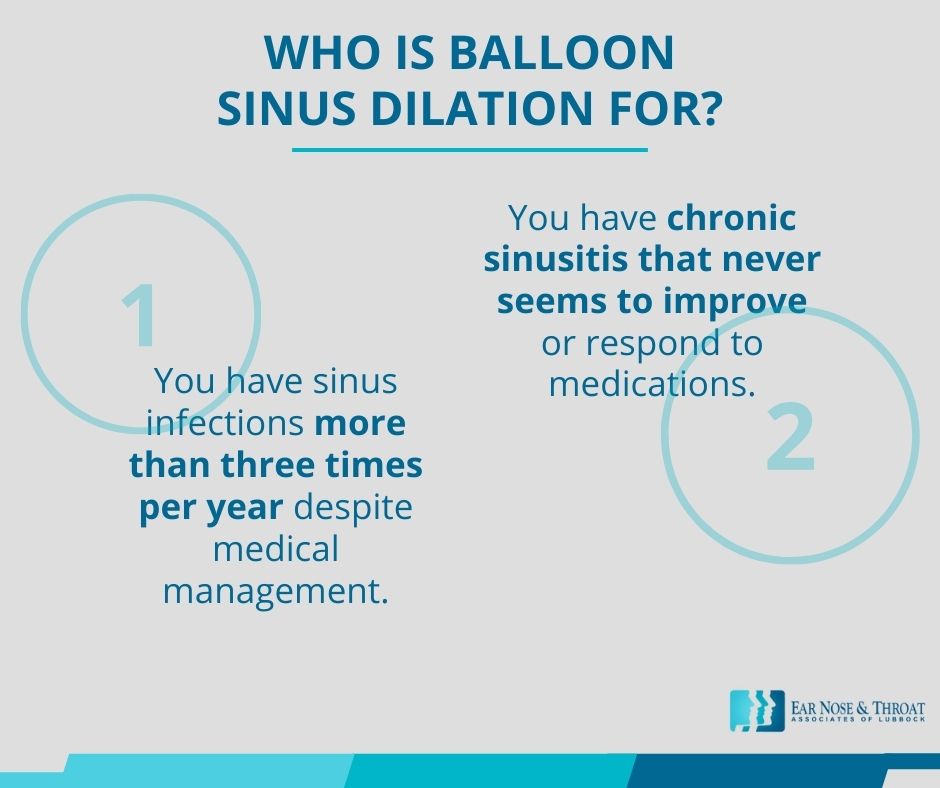Balloon Sinus Ostial Dilation: Everything You Need To Know

You’ve experienced the misery of chronic sinus infections.
Sinus headaches.
Facial pressure.
Congestion.
You’ve tried all the sinus infection home remedies. You’ve been treated with antibiotics, saline nasal sprays, and topical steroid sprays like Flonase. Maybe you’ve even tried allergy shots. But your sinus symptoms haven’t improved.
Maybe now is the time to consider balloon sinus dilation.
A Quick Overview of the Sinuses
Before we take a more in-depth look at balloon sinus dilation, let’s explore the sinuses.
Your sinuses are spaces in your skull that are filled with air and lined with mucous membranes. Each person has four sets of sinuses:
- Frontal sinuses behind the forehead.
- Maxillary sinuses behind the cheeks.
- Ethmoid sinuses between the eyes.
- Sphenoid sinuses behind the nose.
Your sinuses help lighten your skull and allow your voice to reverberate. They also produce mucus that lubricates the inside of your nose.
Although the sinuses are usually air filled, they can become blocked under a number of conditions. When mucus can’t drain out of the sinuses well, it accumulates in these normally open cavities instead. This moist environment is not only uncomfortable, but it can also lead to the growth of bacteria that results in a sinus infection.
Some people deal with chronic inflammation from environmental allergies, excessive mucus, or nasal polyps that stop up the sinuses. Other people are born with narrow sinuses, which swell closed more easily.
Balloon sinus dilation can help with most of these conditions.
What’s Involved in Balloon Sinus Dilation?
Over the past 10 years, balloon sinus dilation has emerged as an excellent alternative to endoscopic sinus surgery.
Endoscopic sinus surgery is a more involved procedure that requires general anesthesia and sometimes the removal of bone and tissue. But time and technology have progressed, and today we usually reserve endoscopic sinus surgery for cases where we need to remove tumors or extensive nasal polyps.
Balloon sinus dilation does not require general anesthesia or a visit to a surgery center. Instead, we perform this procedure in the office with minimal sedation and topical anesthesia. Your nose is numbed so you can’t feel the procedure, but you remain awake the entire time.
During the balloon sinus dilation (also called balloon sinuplasty), your ENT physician inserts a small balloon into your nostril using a thin tube with a light and tiny camera attached.
The physician then inflates the balloon to widen your sinus passageway. The balloon stays inflated for about 10 seconds and is then deflated. From beginning to end, the procedure takes about an hour. More than half of that time is spent simply waiting for local anesthesia to take effect and sufficiently numb the nose.
After a short recovery period, the newly widened sinus passages can drain more freely.
Balloon Sinus Dilation Risks and Safety Concerns
As with most medical procedures, patients may have questions and concerns before their balloon sinus dilation.
While no procedure is completely without risk, balloon sinus dilation is extremely safe. Because it requires only topical anesthesia and mild sedation, it does not involve the risks associated with general anesthesia.
Also, the results of balloon sinus dilation are permanent. It provides long-lasting relief from constricted sinuses.
Who Is Balloon Sinus Dilation For?
Balloon sinus dilation treats people who suffer from chronic sinus issues. You may be a good candidate for balloon sinus dilation if you:
- Have sinus infections more than three times per year despite medical management.
- Have chronic sinusitis that never seems to improve or respond to medications.

Balloon sinus dilation can be performed on a broad range of patients, from teens up to the elderly. It is an excellent alternative to endoscopic sinus surgery for those who can’t tolerate general anesthesia due to health concerns.
Because this procedure doesn’t require any incisions, cutting, or removal of tissue, many patients prefer balloon sinus dilation over standard sinus surgery. Any bleeding or tenderness resolves quickly, and there are no long-term side effects. More than 95% of our patients are extremely satisfied with their results after balloon sinus dilation!
If you’re considering balloon sinus dilation for your sinus issues, give us a call. We’d be happy to set up a consultation to find out if this is the right procedure for you.
Dr. Scolaro is a board-certified Otolaryngologist servicing the South Plains area. He has been practicing in Lubbock since 1990 and has earned a reputation as a skilled and experienced surgeon. He currently serves as the Medical Director for Covenant High Plains Surgery Center campuses, is a member of Covenant Health Partners and is an adjunct faculty professor for Texas Tech University Health Sciences Center School of Medicine. Learn more about Dr. Scolaro.
Categories:








